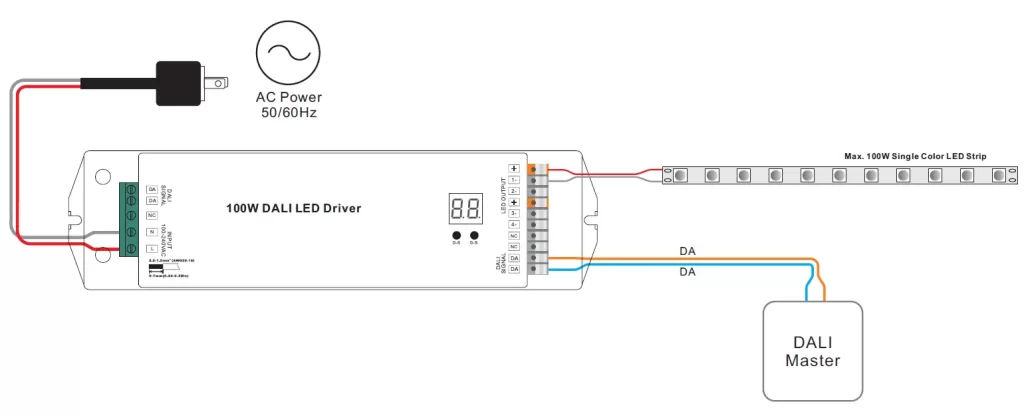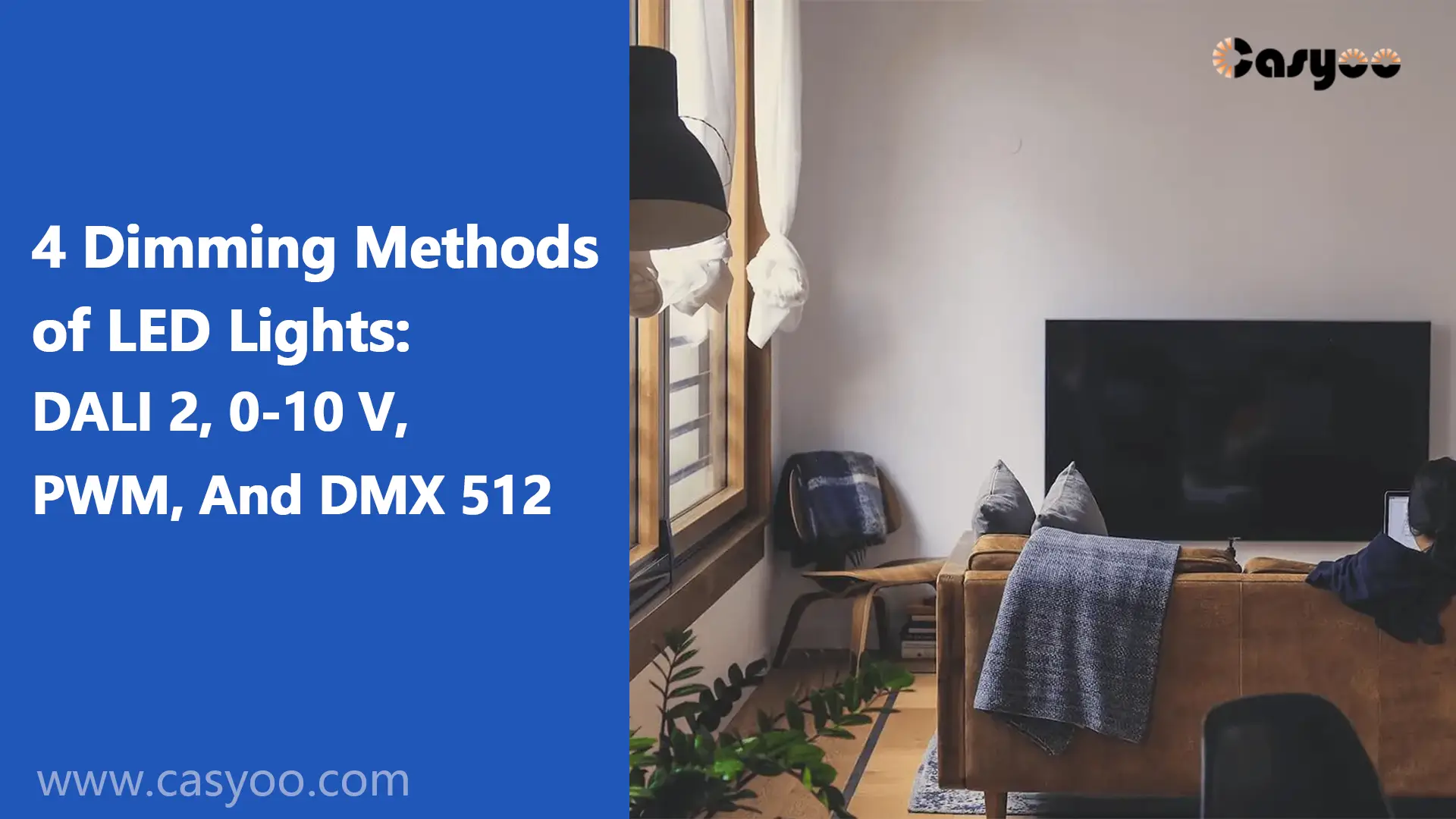LED lights using different chips have varied needs when it comes to dimming drivers. Unmatched lighting equipment and control systems can lead to failure as well as damage to the LED driving circuit and light source. As such, it is critical to discern between various dimming techniques and select a suitable control system. Read this passage to gain a clearer understanding of the most popular light control systems: DALI 2, 0-10 V, PWM, and DMX 512!
Signal types of DALI 2, 0-10 V, PWM, and DMX 512
Analog and digital signals are the two forms of signals that are frequently employed in light control systems. 0-10 V and PWM dimming are considered analog signal systems, while DALI 2 and DMX 512 systems use digital signals.
0-10 V: This analog signal system uses a voltage range from 0 to 10 volts to represent the light fixture’s brightness level; 0 volts denotes an off state, and 10 volts indicates a fully on state. 0–10V control is simple and insufficient to enable complex commands or two-way communication.
PWM: PWM is another analog signal system that modifies the width of the voltage pulse to control the brightness of the light. Usually, there are full-on and full-off voltage switches. Although PWM is capable of precisely controlling the brightness of LED lights, it is not a digital communication protocol because it usually lacks addressing and/or two-way communication capabilities.
DALI 2: DALI-2 makes use of a digital communication protocol to improve lighting systems’ adaptability and interoperability. It provides more sophisticated commands and configuration options, uses bidirectional digital signals for accurate communication between luminaires and controllers, and has feedback and diagnostic capabilities. These capabilities make It suitable for controlling a group of street lights.
DMX 512: DMX 512 is a digital communication system that is widely used for stage lighting and effects management. It uses serial data transmission, which is one-way, to transmit digital signals to lighting equipment. Up to 512 channels of information is in each signal, and each channel controls a different lighting function (like brightness, color, position, or pattern). The gadget accepts and executes console commands by assigning different channel addresses, resulting in precisely synchronized lighting effects.
Control accuracy of DALI 2, 0-10 V, PWM, and DMX 512
A dimming system with great control accuracy can improve the user experience, increase energy efficiency, minimize lamp wear and tear, and allow for precise scene management. The accuracy of the ordering of these four dimming methods is as follows: high-resolution PWM > DALI and DMX 512 > 0-10V.
PWM: The resolution of PWM refers to the number of independent steps that the PWM signal’s duty cycle can be divided into. A PWM system with optimal resolution and clock frequency can achieve extremely high control accuracy. A 16-bit PWM resolution, for instance, can offer 65536 distinct duty cycle levels.
DALI: There are 256 light brightness levels available with the basic DALI system (0 to 255), where 0 denotes no light and 255 denotes maximum brightness. The DALI system can correctly assess the brightness of each lamp and modify it using a non-linear human eye adaptation curve.
DMX 512:DMX 512 is an 8-bit protocol, which means that each channel can have up to 256 different values (0–255). The DMX protocol usually transmits entire frames, containing data from 1 to 512 channels, at an update rate of about 44 times per second. This frequency is adequate for dynamic lighting effects that change quickly.
0-10 V:0-10 V dimming normally uses a mechanical knob; therefore, the user’s actual operational accuracy decides the resolution of this method. Analog signals may attenuate with longer wire lengths and are sensitive to electromagnetic interference, resulting in lower accuracy.
Compatibility of DALI 2, 0-10 V, PWM, and DMX 512
DALI 2, 0-10V, PWM, and DMX 512 protocols are not compatible with all fixtures since each control protocol requires particular hardware and software support.
DALI 2: Lamps must pass the formal certification of the DALI 2 protocol and comply with the DALI 2 technical standards set by the DALI Alliance (Digital Illumination Interface Alliance, DiiA) before they may use the DALI system. The lamp must have a DALI 2 compatible hardware interface, such as an integrated DALI 2 controller.
0-10 V: For connecting 0–10 V control signals, lamps must have a specific input interface. A dimming driver that can react to 0–10V impulses is also essential. To accommodate external control voltages, luminaires need to meet certain electrical requirements.
PWM: PWM systems also require lamp drivers and input circuitry that are PWM signal compatible. PWM dimming can cause electronic components in the fixture to turn on and off often, generating heat. In order to keep components from overheating, luminaires need to include an efficient thermal management system. This is also a reason why LED lights are often suitable for PWM dimming. They can respond quickly to current fluctuations without causing damage.
DMX 512: Lights using DMX system require basic parts, including terminal resistors, DMX protocol interfaces, and DMX decoders. Each DMX-compatible fixture requires a set number of channels to control its various functionalities individually. The fixtures must support channel assignment settings in order to respond to commands sent from the DMX interface.
Cabling and networking
DALI: DALI uses simple, two-wire wiring that doesn’t require polarity. Up to 64 devices can be connected to a single DALI loop. The system enables multi-loop networking and is appropriate for controlling large-scale projects. It supports two-way communication and is capable of receiving feedback data from the gadget. The system settings and initial equipment configuration are a little complicated.
0-10 V&PWM: 0-10 V and PWM both require two wires to send signals to dim the light. There is no device address in the network, and lighting on the same control line cannot be operated independently. Additionally, the load is unable to provide feedback to the controller. These two systems have limited networking capabilities. However, it is less expensive and appropriate for basic brightness control requirements.
DMX 512: DMX 512 transmits differential signals via a pair of twisted pairs with a 120-ohm impedance, giving anti-interference capabilities. A single link can connect up to 32 devices, each with its own starting address, which collects signals from 512 channels. For inexperienced users, configuring and optimizing a DMX system might be challenging.

Conclusions
DALI 2, 0-10 V, PWM, and DMX 512 dimming systems vary from each other in terms of signal types, control accuracy, compatibility, cabling, and networking. Systems like 0-10 V and PWM can dim the lights in an easy and cheap way, while DALI and DMX can achieve more light effects and functions like two-way communication. Tell us about your specific requirements and let us help decide which light control system is best for you.




